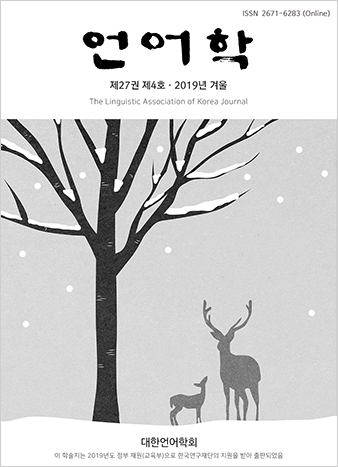대한언어학회 전자저널

-
Anyway as an Unassociative Stance Marker in the American Television Talk Show, Larry King Live
-
Influences of a Native English Teacher and Roles of a Co-teacher on L2 Learners' Learning Styles
-
On the Functions of the Simple Present Tense in The Pilgrim’s Progress
-
Teaching English through Vlogging and In-class Presentation: A Preliminary Comparative Study
27권 4호 (2019년 12월)
- On the Functions of the Simple Present Tense in The Pilgrim’s Progress
-
Sungkyun Shin
Pages : 91-103
Abstract
Keywords
# function # the simple present tense # historical present # The Pilgrim’s Progress
References
- Algeo, J., & Butcher, C. A. (2014). The origins and development of the English language. Wadsworth: Cengage Learning.
- Bunyan, J. (1678). The pilgrim’s progress (Part I). Published 2014. Minneapolis: Desiring God. www.desiringGod.org
- Bunyan, J. (1684). The pilgrim’s progress. (Part II). J. B. Wharey, revised by R. Sharrock. (1960). Oxford: Oxford University Press.
- Chomsky, N. (1986). Knowledge of language: Its nature, origin and use. New York: Praeger.
- Chomsky, N. (2006). Approaching UG from below. Unpublished paper. MIT.
- Curme, G.O. (1931). Syntax. Boston: D.C.Heath and Company.
- Enos, R. (1981). The use of the historical present in the Gospel according to St. Mark,. Linguistic Association of the Southwest Journal, 3(4), 281-298.
- Fludernik, M. (1992). The historical present tense in English literature: An oral pattern and its literary adaptation. Language and Literature, 17, 77-107.
- Higuchi, M. (1996). The simple present tense used as historical present in English. https://core.ac.uk/download/pdf/147423602.pdf
- Horner, B. (2003). The pilgrim\\\\\\\\\\\\\\\\\\\\\\\\\\\\\\\\\\\\\\\\\\\\\\\\\\\\\\\\\\\\\\\'s progress – Accurate revised text. Bunyan Ministries. Lindenhurst: Reformation Press.
- Huddleston, R., & Pullum, G. K.. (2002). The Cambridge Grammar of the English Language. Cambridge: Cambridge University Press.
- Jespersen, O. (1965/1909-1949). A Modern English grammar on historical principles. Copenhagen: George Allen & Unwin.
- Kiparsky, P. (1968). Tense and Mood in Indo-European. Foundations of Language, 4, 30-57.
- Leech, G. (1971). Meaning and the English verb. London: Longman.
- Leung, M. M. (2008). The narrative function and verbal aspect of the historical present in the Fourth Gospel. JETS, 51(4), 703-720.
- McKay, K. L. (1974). Further remarks on the ‘Historical’ present and other phenomena. Foundations of Language, 11, 247-251.
- O’Rourke, J. J. (1974). The historic present in the Gospel of John. Journal of Biblical Literature, 93(4), 585-590.
- Palmer, F. R. (1965). A linguistic study of the English verb. London: Longman.
- Pascal, R. (1965). The present tense in The Pilgrim’s Progress. MLR, LX, 13-16.
- Quirk, R., Greenbaum, S., Leech, J., & Svartvik, J. (1985). A comprehensive grammar of the English language. London and New York: Longman.
- Radford, A. (2009). Analysing English sentences: A Minimalist approach. Cambridge and New York: Cambridge University Press.
- Radford, A. (2016). Analysing English sentences (2nd ed.). Cambridge and New York: Cambridge University Press.
- Schiffrin, D. (1981). Tense variation in narrative. Language, 57(1), 45-62.
- Shin, S. (2016). Chomsky’s fallacies of merge mutation(s) with respect to abstractness of English. Studies in Linguistics, 39, 163-187.
- Shin, S. (2019a). A diachronic study of the simple present tense in English: Focusing on the present perfect progressive. Paper presented at the Spring Conference of ELSOK on June, 2019.
- Shin, S. (2019b) A diachronic study of the historical present in English. Paper presented at the Spring Conference of JELLA and JWL in 2019.
- Steadman, J. M. Jr. (1917). The origin of the historical present in English. Studies in Philology, 14(1), 1-46.
- Wolfson, Nessa. (1978). A feature of performed narrative: the conversational historical present. Language in Society, 7, 215-237.
- Wolfson, Nessa. (1979). The conversational historical present alternation. Language, 55, 168-182.
- The Historical Present. Retrieved April 22th, 2019 from https://learningenglish.voanews.com/a/everyday-grammar-reported-speech-and-historic-present-tense/4010017.html
- EnglishCafe. Retrieved April 22th, 2019 from https://www.englishcafe.jp/englishcollege/etense2/e1-2-1.html